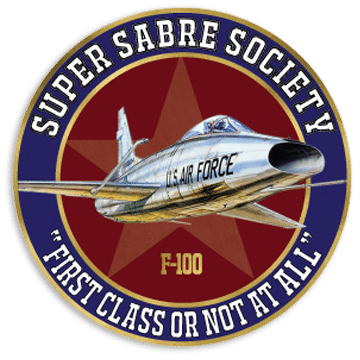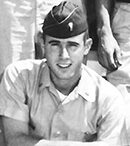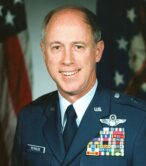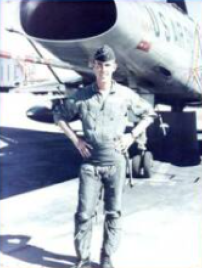Jon Reynolds was born and raised in Philadelphia. He was an engineering major at Trinity College, CT, and upon graduation obtained his Air Force commission via US Air Force ROTC.
Following pilot training in the T-34 and T-28, he was assigned to Luke and Nellis AFB’s flying the F-100C/F and then the 429th Tactical Fighter Squadron at Cannon AFB, NM. He participated in multiple Cold War deployments including the Cuban Missile Crisis in Oct 1962. In the spring of 1963 he was assigned as a forward air controller for the Vietnamese 22nd Infantry Division in Kontum, SVN(Flying the L-19A) directing airstrikes against Viet Cong forces. In the spring of 1964, he was assigned to the 334th F-105 Squadron at Seymour Johnson AFB. In the summer of 1965, he deployed first to Yokota AB, Japan, and then to Takhli AB Thailand flying strikes against North Vietnam. On November 28, 1965, he was shot down on a mission over NVN, captured, and spent more than seven years as a prisoner of war.
Upon his repatriation in 1973 he chose to remain in the military and taught military history at the US Air Force Academy after receiving his MA at Duke University in 1975. He was assigned to Air Force Plans in the Pentagon, completed his PhD at Duke in 1980, and served on the faculty of the National War College. In 1982 he joined the Defense Intelligence Agency and studied Mandarin Chinese. In 1984 he was assigned as air and defense attache at the US Embassy in Beijing where he was the senior US military representative in the People’s Republic of China and was promoted to Brigadier General.
Gen. Reynolds retired from active duty in 1990 and joined The Raytheon Company. His first project was the destruction of chemical weapons on Johnston Atoll. From 1993 to 2000, he and his wife Emilee again lived in Beijing where he was responsible for all of Raytheon’s sales and operations in China, Hong Kong, and Mongolia. Jon and Emilee have two grown children Elizabeth and Andrew.
To see artifacts from BGen Jon A. Reynolds’ career, now on display at the Air Mobility Command Museum. Click here: Brig. Gen. Jon A. Reynolds Archives – Air Mobility Command Museum (amcmuseum.org)
The family of Brigadier General Jon A. Reynolds notified us on April 16th of Jon’s passing.
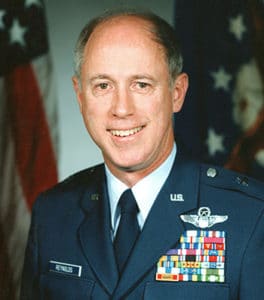 Brigadier General Jon A. Reynolds is a retired United States Air Force (USAF) officer who served in the Vietnam War. He was a prisoner of war in North Vietnam from November 1965 to February 1973. Following his release from captivity, he continued his USAF career, finally serving as assistant deputy director for attaches.
Brigadier General Jon A. Reynolds is a retired United States Air Force (USAF) officer who served in the Vietnam War. He was a prisoner of war in North Vietnam from November 1965 to February 1973. Following his release from captivity, he continued his USAF career, finally serving as assistant deputy director for attaches.
He was born on 13 December 1937 in Philadelphia and graduated from Lower Merion High School, Ardmore, Pennsylvania, in 1955. He received a bachelor’s degree in engineering from Trinity College in 1959.[1]”
Jon Reynolds “was commissioned as a Second Lieutenant through the Air Force Reserve Officer Training Corps program and entered active duty in December 1959. From January 1960 to January 1961 he attended primary pilot training at Malden Air Force Base, MO, and basic pilot training at Craig Air Force Base, Alabama. He then was assigned to advanced flight training in the F-100 Super Sabre at Luke Air Force Base, AZ, and Nellis Air Force Base, NV. In January 1962 he transferred to the 429th Tactical Fighter Squadron at Cannon Air Force Base, New Mexico, as an F-100 pilot.[1]
In March 1963 he was assigned as an air liaison officer and forward air controller with the Army of the Republic of Vietnam 22nd Infantry Division. He returned to the United States in February 1964 and was assigned to the 4th Tactical Fighter Wing, Seymour Johnson Air Force Base, North Carolina, where he flew the F-105 Thunderchief. During 1964 and 1965, as a member of the 334th and 335th Tactical Fighter Squadrons at Seymour Johnson, he participated in squadron deployments to Incirlik Air Base, Turkey; Yokota Air Base, Japan; Osan Air Base, South Korea; and Takhli Royal Thai Air Force Base, Thailand.[1]
On 28 November 1965, while flying a mission near Yên Bái, North Vietnam, his F-105D was shot down, he ejected, was captured, and interned as a prisoner of war. On 6 July 1966, he was one of the prisoners forced to participate in the Hanoi March. He was among the first group of American prisoners released during Operation Homecoming on 12 February 1973.”[1] Jon memorized about 300 POW names and carried them back with them when he was released.
He retired from the USAF on 1 September 1990.[1]
Later life
Following his retirement he joined Raytheon Company as vice president for international technology programs, first working on the destruction of American chemical weapons at the Johnston Atoll Chemical Agent Disposal System and then as head of sales in China from 1994 to 2000.[2]
Decorations
His military decorations and awards include the Distinguished Service Medal; Silver Star with oak leaf cluster; Defense Superior Service Medal; Legion of Merit; Distinguished Flying Cross; Bronze Star with “V” device and oak leaf cluster; Air Medal with 6 oak leaf clusters; Purple Heart; Meritorious Service Medal with two oak leaf clusters; Republic of Vietnam Campaign Medal and Santos-Dumont Merit Medal.” (1)
Jon is survived by his wife Emilee and children Elizabeth Reynolds Peltz and Andrew Reynolds.
Source: Wikipedia
In His Words…
During 1965 I was based at Seymour Johnson AFB, North Carolina. In July we deployed to Yokota AB, Japan and then in November, we redeployed to Takhli AB, Thailand. We were flying F-105D type aircraft. I was shot down on a mission near Yen Bai and was captured immediately. The first American with whom I had contact was Commander Stockdale. On 23 December 1965, I moved from Heartbreak Hotel to the Zoo, remaining there until 11 June 1966. On 6 June I participated in the Hanoi Parade with Bob Purcell. From 11 June 1966 to 2 February 1967, I was at Briarpatch, then Little Vegas and Dirty Bird. On 24 May 1968,1 and nineteen others opened Camp Hope at Son Tay. We closed this camp on 14 July 1970 when we moved to Camp Faith – the worst move I ever made. After the 1970 raid, we moved to Camp Unity, staying there until 13 May 1972. The last camp I opened was Dogpatch. We left Dogpatch for release on 20 January 1973. Repatriation followed on 12 February 1973.
“Jon Reynolds in mentioned in Benjamin Schemmer’s “THE RAID.” It states:
By one of the great ironies of the Son Tay raid, on the day after Bull Simons was picked to lead it, the prisoners there were moved to another camp. A few weeks earlier the well inside Son Tay had dried up. Then the worst monsoon rains in years hit North Vietnam. The prisoners didn’t know that just outside the compound, the Song Con River was flooding water to within a foot or two of the west wall. Indeed, one prisoner, Air Force Major Jon A. Reynolds, would recall later that only days before the move, he was being punished by spending a few days at the bottom of the well- and that it was dry. But very clear, high-altitude aerial reconnaissance photos taken at the time showed that the camp was near being flooded.
The move from Son Tay was orderly, almost casual, not the kind of “panic move” the prisoners would experience later. The guards had ordered them a few days before to take down the clothesline, then the volleyball net and posts. The next day, they loaded hogs and chickens aboard some trucks. Then they were told to take inventory of their dishes and blankets. Finally, they were ordered aboard buses. That night, July 14, 1970, they were all driven to a converted Army barracks at Dong Hoi, 15 miles to the east. The prisoners immediately named the place Camp Faith.”
—–
The Air Mobility Command Museum at Dover AFB in Delaware has a special collection of items belonging to Brigadier General Jon A. Reynolds including (among others) a: P4-B Flying Helmet, Helmet Bag, Helmet Visor Cover, Montagnard knife, Soap with a secret dictionary, Cap and mittens, B-3A Flying gloves and Hanoi Hilton brick, Son Tay Camp Roof Tile, POW/MIA Bracelets, Vietnam Courier Newspaper, Wallet, Toothpaste, Matches, Cigarettes, Kit Bag, Family Photographs, Prisoner of War Propaganda Photographs, Prisoner of War ID Photographs Book, Socks, Flying Suit, and Book and Music Notes, a House Plan, and a Prayer he scribbled while in captivity.
(https://amcmuseum.org/collections/special-collections/brig-gen-jon-a-reynolds/)
